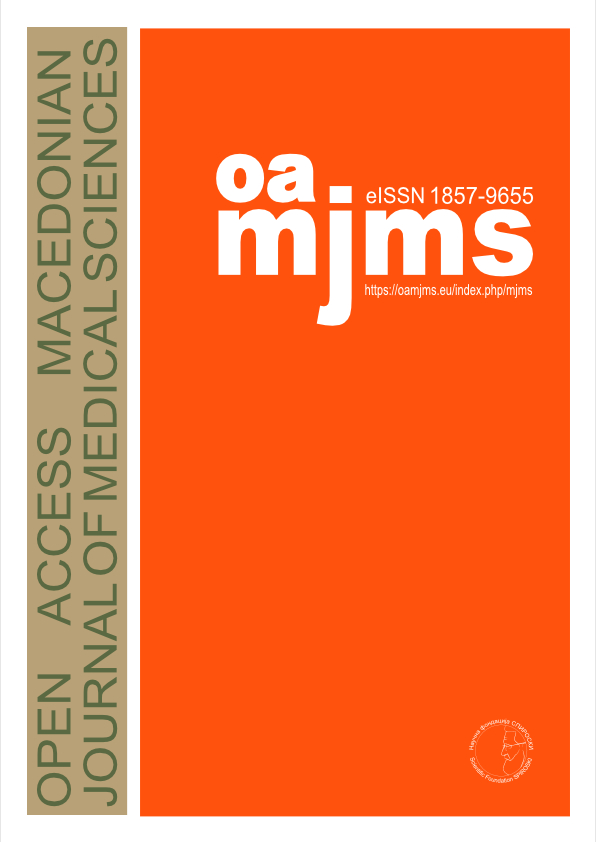Musculoskeletal Disorders at Work among Slovenian Physiotherapists: Prevalence and Risk Factors
DOI:
https://doi.org/10.3889/oamjms.2024.11952Keywords:
Musculoskeletal disorders at work, Slovenian physiotherapists, Prevalence, Ergonomic risk factorsAbstract
BACKGROUND: Musculoskeletal disorders at work (MSDWs) remain the most common health problem in the European Union, particularly in Slovenia, where the prevalence of MSDWs is slightly above the European average. Despite the extensive literature on MSDWs in the health sector, there is little research on physiotherapists (PTs), especially in Europe. Our previous study showed a high prevalence of MSDWs among PTs, with the lower back, neck, and shoulder being the most affected.
AIM: The aim of this study was to investigate the prevalence of MSDWs among Slovenian PTs, ergonomic factors, and the association between MSDWs and demographics and MSDWs and ergonomic risk factors.
METHODS: The survey covered Slovenian PTs working in different health-care settings, using a non-randomized snowball sample. 198 PTs participated, after excluding 22 incomplete questionnaires, 176 PTs remained in the final sample. Data were collected through questionnaires covering demographics, ergonomic risk factors, and the incidence of pain and discomfort in the body.
RESULTS: The lifetime prevalence of MSDWs among 176 FTs was 97.7%. The most affected body regions were the neck (79.5%), upper back (59.2%) and lower back (51.7%). The 1-year prevalence of MSDWs was 94.9%, with the highest prevalence in the upper back (69.3%), neck (66.5%) and lower back (64.3%). The study identified a weak negative association between the prevalence of MSDWs and factors such as age, working life, and job satisfaction across various body regions.
CONCLUSIONS: The results of the survey confirm a high prevalence of MSDWs among Slovenian PTs, which is comparable to European surveys. Key risk factors include ergonomic load and demographic variables. These data highlight the need to improve working conditions and ergonomic measures in physiotherapy practice. The study contributes to a better understanding of MSDWs among PTs in Slovenia and provides a basis for further research and interventions to reduce the risk of MSDWs.
Downloads
Metrics
Plum Analytics Artifact Widget Block
References
CDC. Work-Related Musculoskeletal Disorders and Ergonomics; 2020. Available from: https://www.cdc.gov/ workplacehealthpromotion/health-strategies/musculoskeletal- disorders [Last accessed on 2024 Sep 29].
De Kok J, Vroonhof P, Snijders J, Roullis G, Clarke M, Peereboom K, et al. Work-related MSDs: Prevalence, costs and demographics in the EU. In: European Risk Observatory. Executive Summary. Luxembourg: Publications Office of the European Union; 2019. Available from: https://osha.europa.eu/sites/default/files/work_related_msds_prevalence_costs_and_ demographics_in_eu_summary.pdf [Last accessed on 2024 Sep 29].
Zerbo Šporin D, Prijon T. Z delom povezana kostno-mišična obolenja. In: Zerbo Šporin D, editor. Aktivnosti za Preprečevanje Kostno-mišičnih Obolenj in Psihosocialnih Tveganj Pri Delu. Koper: Založba Univerze na Primorskem; 2021. p. 13-69.
Kotnik P, Koprivnik N. Musculoskeletal disorders in the workplace of physiotherapists: Occupational risk factors and their role in prevention and management: A systematic review. Open Access Maced J Med Sci. 2024;12(2):347-55. https://doi.org/10.3889/oamjms.2024.11900
Gorce P, Jacquier-Bret J. A systematic review of work related musculoskeletal disorders among physical therapists and physiotherapists. J Bodyw Mov Ther. 2024;38:350-67. https://doi.org/10.1016/j.jbmt.2024.01.025 PMid:38763580
Tišlar MH, Starc G, Kukec A. Work-related musculoskeletal disorders among physiotherapists and physiotherapy students in Croatia and their association with physical fitness. Zdr Varst. 2022;61(3):171-80. https://doi.org/10.2478/sjph-2022-0023 PMid:35855374
Anyfantis ID, Biska A. Musculoskeletal disorders among Greek physiotherapists: Traditional and emerging risk factors. Saf Health Work. 2018;9(3):314-8. https://doi.org/10.1016/j.shaw.2017.09.003 PMid:30370163
Kinaci E, Ataoğlu S. Work related musculoskeletal disorders among the physiotherapists: Sample of a region in Turkey. Turk Klin J Health Sci. 2020;5(3):495-502. https://doi.org/10.5336/healthsci.2019-71762
Kakaraparthi VN, Vishwanathan K, Gadhavi B, Reddy RS, Samuel PS, Alshahrani MS, et al. The prevalence, characteristics, and impact of work-related musculoskeletal disorders among physical therapists in the Kingdom of Saudi Arabia - a cross-sectional study. Med Pr. 2021;72(4):363-73. https://doi.org/10.13075/mp.5893.01114 PMid:34467955
Ezzatvar Y, Calatayud J, Andersen LL, Aiguadé R, Benítez J, Casaña J. Professional experience, work setting, work posture and workload influence the risk for musculoskeletal pain among physical therapists: A cross-sectional study. Int Arch Occup Environ Health. 2020;93(2):189-96. https://doi.org/10.1007/s00420-019-01468-7 PMid:31455983
Meh J, Bizovičar N, Kos N, Jakovljević M. Work-related musculoskeletal disorders among Slovenian physiotherapists. J Health Sci. 2020;10(2):115-24. https://doi.org/10.17532/jhsci.2020.880
Šbül T, Jakovljević M, Levec T. Slovenska Priredba, Ustreznost in Uporabnost Razširjenega Nordijskega Mišično-Kostnega Vprašalnika = Slovenian Adaptation, Suitability and Applicability of Extended Nordic Musculoskeletal Questionnare. [Graduation Work]. Ljubljana: Faculty of Health; 2016.
Jacquier-Bret J, Gorce P. Prevalence of body area work-related musculoskeletal disorders among healthcare professionals: A systematic review. Int J Environ Res Public Health. 2023;20(1):841. https://doi.org/10.3390/ijerph20010841 PMid:36613163
1KA. O 1KA. b.d. Available from: https://www.1ka.si/d/sl/o-1ka [Last accessed on 2024 Sep 29].
Yi YZ, Pillai SG, Ramalingam V, Hui OJ. Prevalence of work related musculoskeletal disorders (WRMSD) and the associated risk factors among Malaysian physiotherapists: A cross sectional study. J Phys Educ Sport. 2022;22(334):2636-41. https://doi.52/jpes.2022.11334
Le TT, Jalayondeja W, Mekhora K, Bhuuanantanondh P, Jalayondeja C. Prevalence and risk factors of work-related musculoskeletal disorders among physical therapists in Ho Chi Minh City, Vietnam. BMC Public Health. 2024;24(1):6. https://doi.org/10.1186/s12889-023-17527-1 PMid:38166897
Hinkle DE, Wiersma W, Jurs SG. Applied Statistics for the Behavioral Sciences. Boston, MA: Houghton Mifflin Company; 2003.
Iqbal Z, Alghadir A. Prevalence of work-related musculoskeletal disorders among physical therapists. Med Pr. 2015;66(4):459-69. https://doi.org/10.13075/mp.5893.00142 PMid:26536963
Khairy WA, Bekhet AH, Sayed B, Elmetwally SE, Elsayed AM, Jahan AM. Prevalence, profile, and response to work-related musculoskeletal disorders among Egyptian Physiotherapists. Open Access Maced J Med Sci. 2019;7(10):1692-9. https://doi.org/10.3889/oamjms.2019.335 PMid:31210825
Ameer M, Ashour A. Practising physical therapy affects professionals in Egypt. Physiother Quarter. 2020;28(4):42-7. https://doi.org/10.5114/pq.2020.96235
Alnaser MZ, Aljadi SH. Physical therapists with work-related musculoskeletal disorders in the State of Kuwait: A comparison across countries and health care professions. Work. 2019;63(2):261-268. https://doi.org/10.3233/WOR-192927 PMid:31156207
Desai RG, Shah MK. Prevention of work-related musculoskeletal disorders in physiotherapist - a review. Int J Res Rev. 2021;8(12):497-502. https://doi.org/10.52403/ijrr.20211261
Downloads
Published
How to Cite
Issue
Section
Categories
License
Copyright (c) 2024 Nataša Koprivnik, Petra Kotnik (Author)

This work is licensed under a Creative Commons Attribution-NonCommercial 4.0 International License.
http://creativecommons.org/licenses/by-nc/4.0








